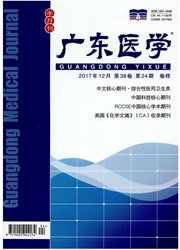

 中文摘要:
中文摘要:
目的比较甲氧氯普胺(MPD)与阿瑞匹坦(APD)在联合地塞米松基础上预防高致吐性化疗(HEC)引起的延迟性恶心呕吐的有效性和安全性。方法将接受HEC的实体瘤患者随机分为MPD组(30例)和APD组(31例),MPD组的止吐方案为MPD20mg,2次/d(d2—4);帕洛诺司琼0.25mg(d1);地塞米松20mg(d1),8mg,2;2次/d(d2~4)。APD组的止吐方案为APD125mg(d1),80mg(d2~3);帕洛诺司琼0.25mg(d1);地塞米松12mg(d1),8mg(d2~4)。主要研究终点是延迟期(化疗后24~120h)内获得完全缓解(定义为无呕吐及未使用解救性止吐药物)的患者百分比(CRR),次要研究终点是不良反应发生率。结果MPD组与APD组在延迟期恶心呕吐的CRR分别为83.3%(25/30)和80.6%(25/31),差异无统计学意义(P〉0.05)。两组主要不良反应为便秘、乏力及呃逆,不良反应发生率差异无统计学意义(P〉0.05),患者均可以耐受。结论MPD联合帕洛诺司琼、地塞米松的止吐方案与标准的三联止吐方案(APD、帕洛诺司琼及地塞米松)相比,在HEC中具有相似的疗效及安全性。
 英文摘要:
英文摘要:
Objective To compare the efficacy and safety between metoclopramide and aprepitant when combined with dexamethasone for prophylaxis of delayed chemotherapy - induced nausea and vomiting (CINV) in patients with highly emetogenic chemotherapy (HEC). Methods Patients with malignant solid tumor, who would receive HEC, were randomly assigned to either metoclopramide (MPD) group or aprepitant (APD) group. MPD group received a combination of metoclopramide (20 mg bid d2 -4) , palonosetron (0. 25 mg dl ) and dexamethasone (20 mg dl, 8 mg bid d2 -4) ; and APD group received aprepitant ( 125 mg dl, 80 mg d2 - 3 ), palonosetron (0. 25 mg dl ) and dexamethasone ( 12 mg dl, 8 mg qd d2 -4 ) for emesis control. The primary end point was complete response (defined as no vomiting and no rescue medication, CR) at the delayed period (24 -120 h after the start of chemotherapy) , and secondary end point was the incidence of side - effects. Results Thirty patients were enrolled in the MPD group and 31 enrolled in the APD group. All patients were evaluable. No significant difference was found between MPD group and APD group in the CR rate of delayed CINV (83.3% vs. 80. 6%, P 〉0. 05). The most common adverse events were constipation, fatigue and hiccups, and all adverse reactions were tolerable. No significant difference was found in side effects (P 〉 0. 05). Conclusion The triple antiemetie therapy with metoclopramide, palonosetron, and dexamethasone shows similar efficacy and safety with the standard triple antiemetic therapy of aprepitant, palonosetron, and dexamethasone in HEC.
 同期刊论文项目
同期刊论文项目
 同项目期刊论文
同项目期刊论文
 期刊信息
期刊信息
